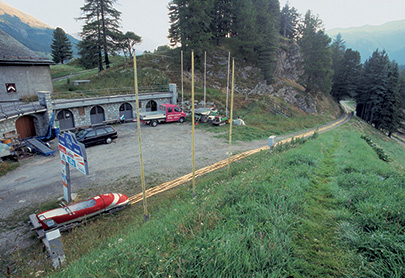 |
|
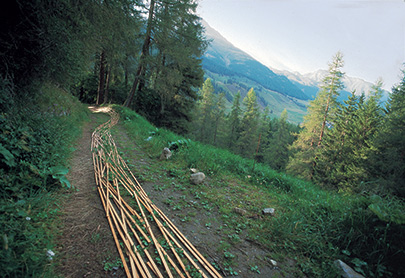 |
|
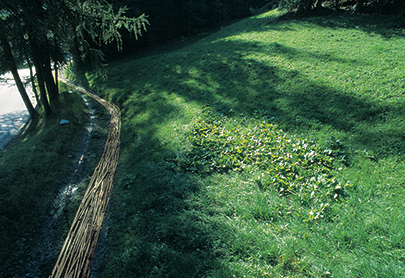 |
|
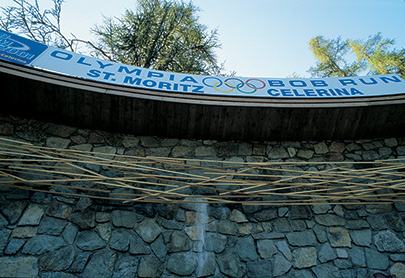 |
|
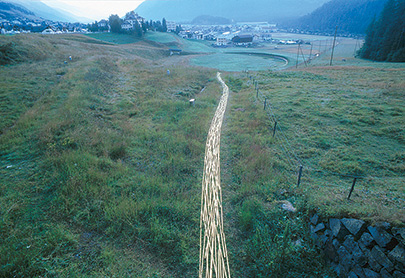 |
|
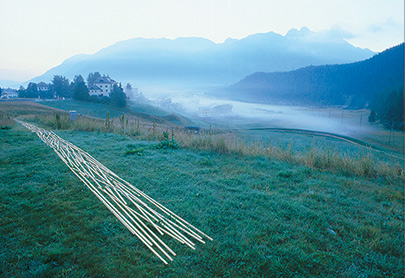 |
|
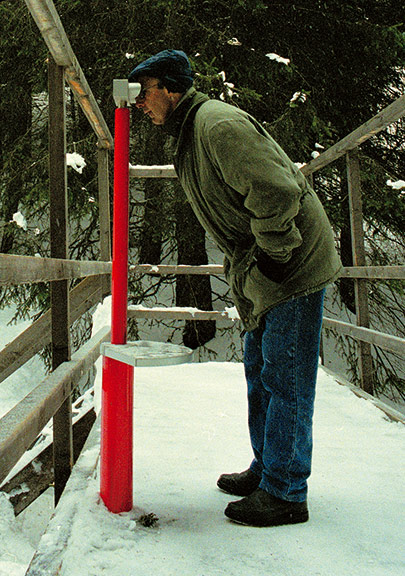 |
|
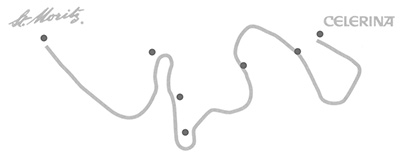 |
|
 |
|
 |
|
 |
|
 |
|
 |
|
 |
|
 |
|
 |
|
The video is 2:07 min long., the descent 1:04:54 min, the record for the bobsled, which races down the Olympia stretch from St. Moritz to Celerina in the summer: a 1.8 kilometre rumbling journey through a landscape that dissolves into green streaks; 1.8 kilometres curving along cow pasture, fences and pines. The ears are filled with a rythmic buzzing, the sound of grinding runners and the racing voice of an excited speaker. The video follows the rules of sport reporting: the camera transports us to the pilot position and we stare intensely over the round bow of the plastic sled. The stone clad curve flies past; we glide shakily over a field of capped straightaways, the embodiment of a flitterung fast but nonetheless single-minded journey.
Invited to the Festival of the Arts in St. Moritz, Daniel Zimmermann brought his preferred work material with him: 2.7-meter long drywaller boards. Already on the site of the Bieler Centre PasquArt and at the Mondsee he had occupied fields and plazas and layered a thoughtful visual structure over the empty places that lifted them out of the everyday routine for a short time. The famous St. Moritz bob course on the other hand seduced him to a humorous procedure. With the help of a circle of friends from dance, theatre and music, he created a trail of some 10.000 spruce boards resembling the traces, a wood- instead of spark-scattering bobsled - in the exhilaration of speed - might leave behind.
That was a very athletic enterprise - not only due to the endurance demanded of the young people in the course of a week of carrying, climbing and screwing. Athletic also in the expenditure of physical energy and financial resources in pursuit of a goal that one can only call absurd in the face of its abstract nature: to embody speed, to hold onto for a moment that would soon only exist in the memory of the witnesses.
Just as sport does, art also uses the camera to tell of the experienced. The race is an easily seen through, but nonetheless amazingly believable and thus humorous falsification. Zimmermann accellerated the image recorded - while walking - on a computer and provided it with a soundtrack. He poured his information into the format developed for television, always simultaneously offering the viewer identification and commentary. Some of those who still imagine the artist as a Bohemian may be surprised at how compatible the systems of sport and art prove to be: in place of the sponsor, the logo of the Swiss sport federation, no, of the Swiss culture foundation supporting the event appears. The artist names himself instead of the driver as the helmsman of the enterprise leading a crew of supporters. Whoever is familiar with how artistic workers fight for grants and commissions will also recognize the video as a mean-spirited satire of the art business: Professional sports, like professionall art, are constructed by our performance society far away from the concerns of a leisure pastime, which one nonetheless loves because of its nature of non-utility. Both become exemplary races, in which our identification figures attept to outdo one another like the avatars of a video game. And in the economic competition, where we often come into conflict with the law of charity and where the art people are shy, in the world of sports we can negotiate the rankings with an open heart: openly mourn losses, sarcastically comment on failure, celebrate victories as compensation.
However, is it actually a race that Daniel Zimmermann allows us to accompany? The speaker, the characteristics of TV broadcasting suggest this. But where are the spectators, the fans leaning over the boundaries of the straightaways? The rumbling journey runs tiredly into the void: into the grass and loneliness. It is also a ghost journey, the bob sled race in summer, as if it had never happened. Was it all for nothing? The brief moment 'afterwards' tells of the sadness of he who gave himself away, who achieved his goal, literally reaching the lowest point at the end of the intoxication. Perhaps the fleeting heroism can only be attributed to the fantasy of one who has trained in loneliness for a distant future, who has gone astray in pursuit of his goal and who envisions just once being greeted by a jubilant crowd? The childlike enthusiasm is followed by a quiet suggestion of absurdity; the track also spits us out into the sobering consciousness of those who were so glad to be fooled
Annina Zimmermann
Art historian, curator and writer - lives and works in Basel.